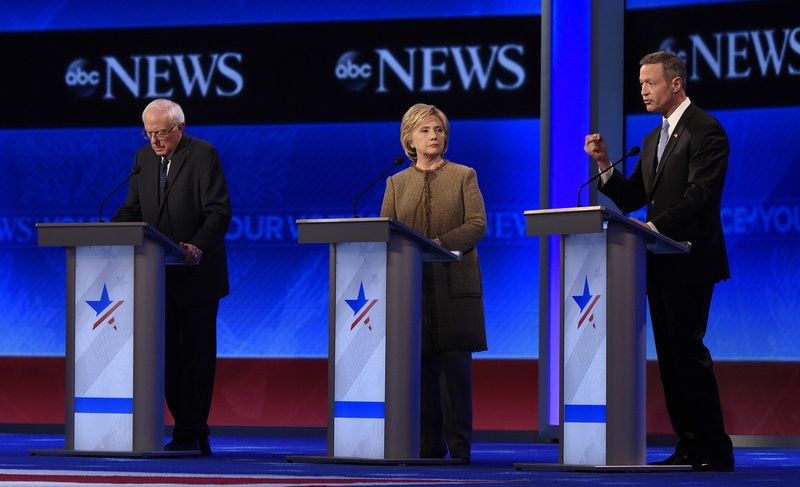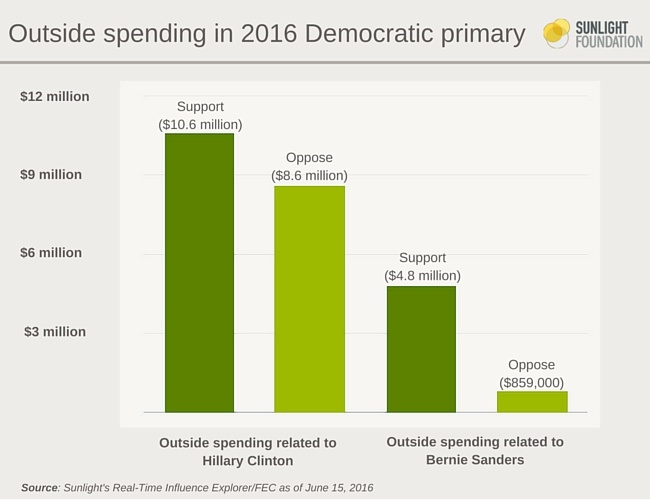Following the money behind the nearly $500 million 2016 Democratic primary

So far, the 2016 presidential election has racked up more than $1.09 billion dollars in spending by candidates and outside groups. Sunlight estimates that the Democratic primary resulted in about $445 million spent by former Secretary of State Hillary Clinton, Sen. Bernie Sanders and former Maryland Gov. Martin O’Malley, as well as their allied super PACs and other groups.
June 20 was the first federal filing deadline since Clinton became the presumptive Democratic nominee, so we used our Real-Time Influence Explorer tool to sift through reports from the Federal Election Commission (FEC) and track the money raised and money spent for Clinton, O’Malley and Sanders during the primary.
Hillary Clinton’s fundraising tour de force
Clinton is in a far different position than Sanders, getting hit by nearly 10 times as much opposition spending as the Vermont senator. But she also had more than double the amount spent supporting her — more than $10 million thus far. Her campaign has doled out $195.7 million so far during the election, which is about $24 million less than Sanders.
Priorities USA, a super PAC that originally formed to support Barack Obama’s election bid, has now spent $5.7 million in support of Clinton, mostly in the form of television, radio and digital ad buys, as well as direct mail. Most of the supporters are longtime donors to the Clintons and the Democratic party. Donors to Priorities USA include liberal megadonors like George Soros ($7 million), James Simons ($3.5 million), Haim and Cheryl Saban ($5 million) and various union groups like Laborers International and the American Federation of Teachers.
Clinton also received $2 million in union support from the Service Employees International Union Committee on Political Education, and Planned Parenthood spent almost $1.9 million supporting her election bid. This support came in the form of digital ads, phone calls and voter outreach.
And it wasn’t just support. Outside groups poured in at least $8.6 million in opposition spending against Clinton. All in all, Clinton had 23 groups, mostly GOP or conservative leaning, pouring in millions to oppose her. And keep in mind – we’re just in the primary season here, so we’ll see this number grow now that she’s the presumptive nominee.
The largest amount of outside spending against Clinton came from the Tea Party Patriots Citizens fund, spending $2.2 million mostly on direct mail and voter calls. Freedom Defense Fund ($1 million), Rebuilding America Now ($1 million ), Citizens United Super PAC LLC ($997,000) and Stop Hillary PAC ($657,000) round out the top five outside groups opposing Clinton.
Clinton has $42 million in cash on hand to take on Donald Trump in November, who by contrast has only $1.3 million in cash on hand.

Bernie Sanders’ small-donor revolution
Sanders nearly matched Clinton in fundraising, raising $229 million compared to her $238 million, according to the latest FEC filings. Sanders spent about $219 million on his campaign through May.
According the Center for Responsive Politics, 62 percent of Sanders’ donations to his campaign came from small donors. Our fundraising database, Political Party Time, had only a handful of fundraisers benefitting him, and Sanders rarely, if ever, attended traditional big-money fetes.
Despite the many, many claims that Sanders didn’t have a super PAC, he did benefit from outside spending – specifically a union-backed super PAC.
As Sunlight first reported in December, Sanders was the beneficiary of a super PAC run by the National Nurses United for Action throughout the primary season — to the tune of $4.6 million. That accounted for about 96 percent of outside spending in support of Sanders. This the most of any union involvement so far in the presidential race, and runs second only to Priorities USA among outside groups.
It’s true that this sort of super PAC help is very different than the single candidate super PACs that assisted Ted Cruz, Jeb Bush and Clinton. Meredith McGehee of the Campaign Legal Center told The Washington Post, “There is a distinction here that does matter, because of the coordination question: Is it truly independent? That’s an important distinction.”
Then there is the very curious case of the ESAFUND, a conservative super PAC bankrolled by GOP megadonors such as Paul Singer, Linda McMahon and the Ricketts family, that spent about $804,000 opposing Sanders. The ads presented Sanders as a “liberal” that supports single-payer healthcare, and some accused the ads of trying to boost Sanders under the guise of opposing him. The ads and voter contact calls happened in January, February and March as key early states were casting ballots for the Democratic nomination. This isn’t the first time an opposition group meddled in another party’s primary — see Missouri Sen. Claire McCaskill’s Senate race in 2014 — but we may never know the intentions of ESA’s ad choice.
Sanders still has $9.2 million in the bank, and only time will tell how he plans to spend that money down the road.
Martin O’Malley’s fundraising lags behind
O’Malley’s short-lived campaign spent $6 million before he dropped out on Feb. 1. Additionally, he was the only candidate to accept public funds, as Sunlight’s Libby Watson reported earlier this year. O’Malley took advantage of a total of $846,365 in public funds.
That did not stop him from benefitting from outside spending. His super PAC, Generation Forward, spent $819,000 throughout the 2016 cycle, about $370,000 for online and TV ads in direct support of O’Malley. The super PAC also spent $10,000 against Democratic rival Sanders in the fall of 2015. The group’s biggest donation came from Retail Systems and Service Inc., with $120,000 – twice as much as the next largest donation of $66,000 from John Deane of the Advisory Board Company. Former Governor of New York, Eliot Spitzer, and his mom, also gave $100,000.
Primary partytime is over
In terms of fundraisers during the primary cycle, no one tops Clinton’s campaign, which has held or scheduled 516 fundraisers as of June 15, according to Political Party Time. O’Malley had 13 fundraisers, while we only had five for Sanders.
And let us not forget the also-rans in former Rhode Island Gov. Lincoln Chafee and former Virginia Sen. Jim Webb. Both candidates did not have outside support from any notable groups and spent $418,000 and $339,000 respectively. All in all, this spending will prove to be a drop in the bucket compared the billions that spent by both sides up and down the ballot in November. We can expect about billion dollars spent by each side in the general election, so stay tuned to our blog here at Sunlight, or follow the money yourself by using our Real-Time Influence Explorer and Political Party Time tools.

